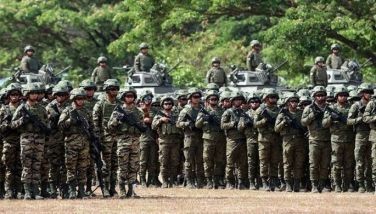Fast, effective prostate cancer treatment at UCPI
April 29, 2002 | 12:00am
Patients with early stage prostate cancer who are unwilling or unsuitable for surgery now have a faster, safer and more affordable option – prostate brachytherapy.
First introduced in November last year by the Urology Center of the Philippine (UCPI) at 132 Kalayaan Avenue, Quezon City (tel. no. 435-2617 to 18; e-mail address [email protected]), prostate brachytherapy – also known as seed therapy, seed implantation or interstitial radiation – is the fastest growing non-surgical treatment for early stage prostate cancer.
This state-of-the-art outpatient procedure is a form of radiation therapy in which radioactive pellets or seeds are implanted into the prostate to deliver high radiation energy directly to the tumor without harming other normal tissues and organs.
"In modern prostate brachytherapy, radiation energy is applied to a limited area, in this case, the prostate, without damaging the surrounding tissue. This makes it better and safer," said Dr. Steve Pai-hsun Lee, assistant professor of the Department of Radiation Oncology of University of California, Los Angeles who visited Manila recently at the invitation of UCPI.
The concept is not new but has been available in some form to urologists and radiation oncologists for decades. It fell into years of relative disuse because the early procedure required surgery and exposed patients to a host of problems.
Faced with these problems, patients with prostate cancer had no option but to undergo either surgery or external beam radiation therapy (where radiation was applied externally and passed through all surrounding organs). Improved technological approaches have changed all that.
Today’s modern brachytherapy usually takes two visits to the doctor. The first is to measure the patient’s prostate by means of ultrasound and the second is for the actual implantation. Ultrasound imaging creates a detailed map of the prostate that is fed into a computer program to plot the exact placement of the radioactive seeds for optimum radiation treatment.
The seeds used are tiny-welded titanium capsules about the size of rice grains. About 60 to 100 seeds are implanted into the prostate through specially designed needles. These small needles puncture the skin and push the seeds into place without any incision. After the operation – which usually takes an hour – the patient may go home.
Because there is no surgery involved, prostate brachytherapy promises less discomfort, faster healing time, fewer complications and, above all, less cost. Unlike surgery, patients don’t have to wait for two weeks to have sex.
Accurately placed seeds also ensure effective radiation treatment without injuring other vital organs around the prostate. Ten-year studies have confirmed that prostate brachytherapy is most effective for early stage cancer and is as effective as traditional treatments (like surgery and external beam radiation therapy), but causes fewer side-effects.
First introduced in November last year by the Urology Center of the Philippine (UCPI) at 132 Kalayaan Avenue, Quezon City (tel. no. 435-2617 to 18; e-mail address [email protected]), prostate brachytherapy – also known as seed therapy, seed implantation or interstitial radiation – is the fastest growing non-surgical treatment for early stage prostate cancer.
This state-of-the-art outpatient procedure is a form of radiation therapy in which radioactive pellets or seeds are implanted into the prostate to deliver high radiation energy directly to the tumor without harming other normal tissues and organs.
"In modern prostate brachytherapy, radiation energy is applied to a limited area, in this case, the prostate, without damaging the surrounding tissue. This makes it better and safer," said Dr. Steve Pai-hsun Lee, assistant professor of the Department of Radiation Oncology of University of California, Los Angeles who visited Manila recently at the invitation of UCPI.
The concept is not new but has been available in some form to urologists and radiation oncologists for decades. It fell into years of relative disuse because the early procedure required surgery and exposed patients to a host of problems.
Faced with these problems, patients with prostate cancer had no option but to undergo either surgery or external beam radiation therapy (where radiation was applied externally and passed through all surrounding organs). Improved technological approaches have changed all that.
Today’s modern brachytherapy usually takes two visits to the doctor. The first is to measure the patient’s prostate by means of ultrasound and the second is for the actual implantation. Ultrasound imaging creates a detailed map of the prostate that is fed into a computer program to plot the exact placement of the radioactive seeds for optimum radiation treatment.
The seeds used are tiny-welded titanium capsules about the size of rice grains. About 60 to 100 seeds are implanted into the prostate through specially designed needles. These small needles puncture the skin and push the seeds into place without any incision. After the operation – which usually takes an hour – the patient may go home.
Because there is no surgery involved, prostate brachytherapy promises less discomfort, faster healing time, fewer complications and, above all, less cost. Unlike surgery, patients don’t have to wait for two weeks to have sex.
Accurately placed seeds also ensure effective radiation treatment without injuring other vital organs around the prostate. Ten-year studies have confirmed that prostate brachytherapy is most effective for early stage cancer and is as effective as traditional treatments (like surgery and external beam radiation therapy), but causes fewer side-effects.
BrandSpace Articles
<
>
- Latest
Latest
Latest
October 14, 2024 - 11:00am
October 14, 2024 - 11:00am
October 11, 2024 - 12:49pm
October 11, 2024 - 12:49pm
September 30, 2024 - 8:00am
September 30, 2024 - 8:00am
September 26, 2024 - 2:00pm
September 26, 2024 - 2:00pm
September 3, 2024 - 1:00pm
September 3, 2024 - 1:00pm
Recommended





























